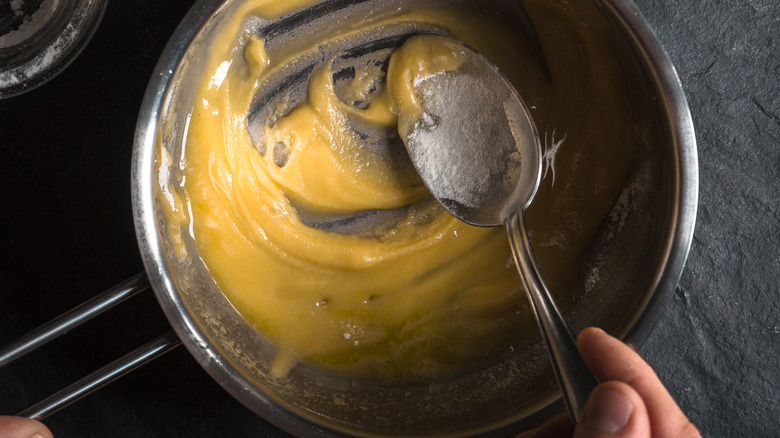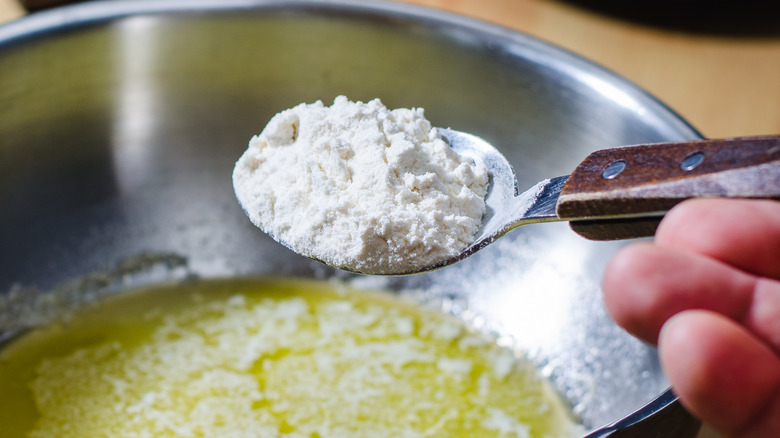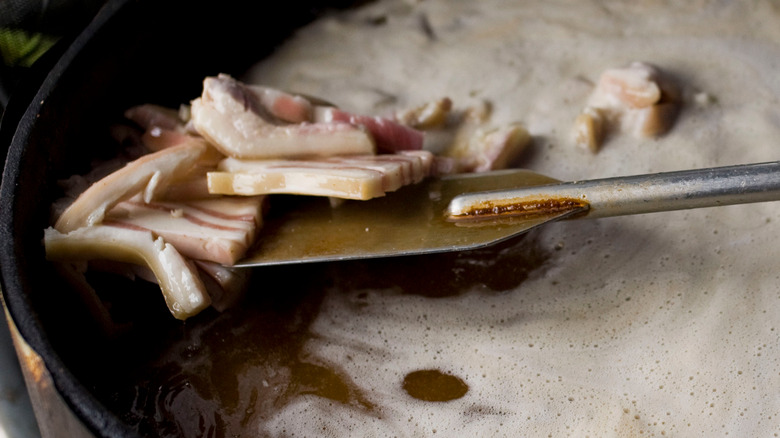How Cajun Roux Differs From The Classic French Version
We may receive a commission on purchases made from links.
When roux first hit the culinary scene in 17th century France, it not only opened the door to new possibilities in the kitchen — it changed our relationship with soups, stews, and sauces for good. According to the Michelin Guide, what defines a roux hasn't changed since its original conception. (For the uninitiated, a roux is a paste made up of equal parts flour and fat that is cooked over heat and used as a thickening and smoothing agent for a variety of liquid-based recipes.) As French culinary influence spread throughout the world, so did its roux — and in a lot of ways, the rest was simply history.
Today, not only is roux the basis of four of the five French mother sauces as defined by monoliths like the Auguste Escoffier School of Culinary Arts, but it's also the lifeline of a variety of saucy dishes in different parts of the world, like the Southeastern United States. Creole and Cajun cookery incorporated roux into their respective recipes, and most gumbos today rely on roux as their base. Of course, with every recipe comes room for personalization, and Cajun roux is no different. So, what makes Cajun roux unique compared to its French counterpart?
The difference between French roux and Cajun roux
According to MasterClass, there are actually four types of roux that vary by cook time and usage. First on the list are white roux and blond roux, both of which are what people typically associate with French cooking. White roux is cooked the least, has a neutral flavor, and is used as a quick and easy thickener. (It's also considered the key ingredient in another one of the French mother sauces: béchamel sauce.) Then there's blond roux, which is cooked until it reaches a yellow hue. While both might appear slightly similar in color to the untrained eye, that's certainly not the case when it comes to flavor: in comparison to white roux, blonde roux has a nuttier flavor profile and is commonly used in velouté sauce. The third type of roux is brown roux, which boasts an even nuttier flavor than blonde roux, per MasterClass. The catch? The more a roux is browned, the less thickening power it tends to have.
It's for this reason that the final type of roux, dark roux, is considered the most flavorful but the least helpful as a thickener in recipes. As it turns out, dark roux is also the type of roux that's most common in Cajun cooking. But that's not the only way Cajun roux sets itself apart. In French cuisine, roux is generally made with white flour and butter — but with Cajun roux, lard or oil is the emulsive ingredient used as the roux's fat component, per the Michelin Guide.
The best way to cook with Cajun roux
As the Michelin Guide notes, a big reason why Cajun roux relies on lard or oil instead of butter is that butter is more likely to burn the longer it's cooked. Because preparing a dark roux can take anywhere from twenty minutes to over an hour to prepare, it's important that all that hard work monitoring and stirring the roux doesn't go to waste by using the wrong kind of fat (via the Food Network). Since Cajun and Creole classics like étouffée, gumbo, and jambalaya are hearty recipes with bold flavor profiles, they require a dark roux to help boost their flavor and amplify the other ingredients in the dish. Typically, lards such as bacon fat can further help add depth.
There are lots of ways to thicken a sauce, of course. As food blogger and media personality Ree Drummond notes on her blog The Pioneer Woman, among them include adding starches such as cornstarch or arrowroot, reducing the sauce by letting it cook over low heat for an extended period of time, and many other tried and true techniques. However, none of these methods has quite the same history and flavor-enhancing properties as a roux. It's for these reasons that Cajun roux is here to stay.


